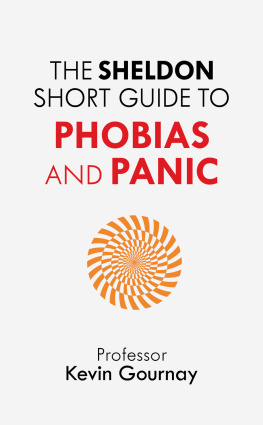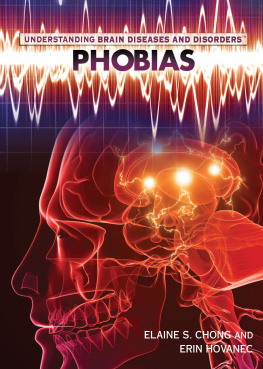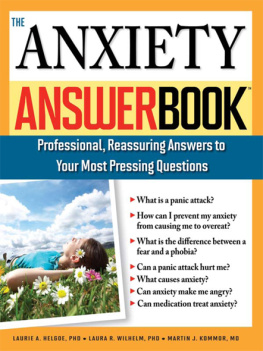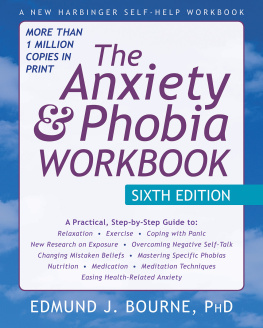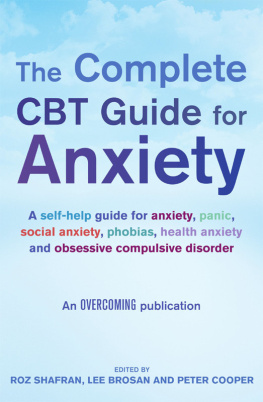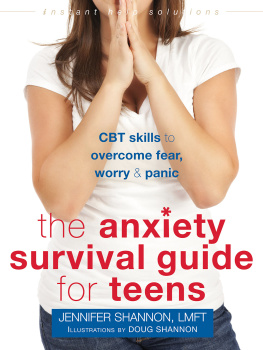
The Sheldon Short Guide to
Phobias and Panic
Professor Kevin Gournay CBE is an Emeritus Professor at the Institute of Psychiatry, Psychology and Neuroscience (Kings College, London). In his clinical work at the Priory Hospital, north London, he treats phobias, panic and other anxiety disorders, including post-traumatic stress disorder and obsessivecompulsive disorder. He has managed research and training projects in the UK and across the world, and is a consultant to the World Health Organization. He has written extensively and is the author of several Sheldon books. As well as being the president and founding patron of No Panic, he is also a patron and adviser to several other charities.
Sheldon Short Guides
A full list of titles in the Overcoming Common Problems series is also available from Sheldon Press, 36 Causton Street, London SW1P 4ST and on our website at www.sheldonpress.co.uk
Depression
Dr Tim Cantopher
Memory Problems
Dr Sallie Baxendale
Phobias and Panic
Professor Kevin Gournay
Worry and Anxiety
Dr Frank Tallis
THE SHELDON
SHORT GUIDE TO
PHOBIAS
AND PANIC
Professor Kevin Gournay

First published in Great Britain in 2015
Sheldon Press
36 Causton Street
London SW1P 4ST
www.sheldonpress.co.uk
Copyright Professor Kevin Gournay 2015
All rights reserved. No part of this book may be reproduced or transmitted in any form or by any means, electronic or mechanical, including photocopying, recording, or by any information storage and retrieval system, without permission in writing from the publisher.
The author and publisher have made every effort to ensure that the external website and email addresses included in this book are correct and up to date at the time of going to press. The author and publisher are not responsible for the content, quality or continuing accessibility of the sites.
British Library Cataloguing-in-Publication Data
A catalogue record for this book is available from the British Library
ISBN 9781847093691
eBook by Fakenham Prepress Solutions, Fakenham, Norfolk NR21 8NN
Fear is normal. I probably use these three words every time I see a new client who comes to me with phobic anxiety or panic. The problem with fear is that, as with many normal phenomena, it can simply get out of hand. Fear can grow into a phobia, so that the presence of a particular object, or being in a particular situation, leads to a level of fear that is unpleasant and overwhelming and makes you want to escape from it at the earliest possible opportunity. Likewise, nervousness, which everyone feels on some occasions, can grow to such an extent that we become overwhelmed by a mixture of physical feelings and thoughts of such intensity that we feel like a catastrophe is about to occur death is imminent, or a loss of control, or madness.
Fear is an essential part of all our lives. If you think about it, people without fear would be killed the first time they crossed a road. Ask yourself: Is it normal to have some fear and apprehension? If the choice is walking down a well-lit road or taking a shortcut through a dark underpass late at night, what stops us choosing the riskier route? Fear has a survival function: it protects us from making unwise choices and walking through the dark underpass instead of down the well-lit road. Fear also protects us in a physical sense. The hormone of fear adrenaline prepares our body for fight or flight responses to situations.
Phobias and panic may happen when fear gets out of hand, and I deal with these two topics together as they are often inextricably linked. The majority of people I see in outpatient clinics with phobias experience panic attacks, and the pattern of their panic can become as much of a problem as the phobia. In this book I describe a tried and tested self-help programme, which I designed more than 15 years ago.
A key word is exposure . To remove phobic fears from your life, you need to face them, and this guide teaches you how to do that.
There is an emphasis on two principles:
exposure to phobias and panic needs to be carried out in steps, with you gradually increasing your efforts;
exposure should be at a level that you find difficult, but manageable. If you try to push yourself too far, you will suffer setbacks.
I must emphasize that this book will not have all the answers. I do hope, however, that in helping you to help yourself, I can at the very least point you in the right direction.
Phobias and panic are anxiety states . Anxiety states may be classified into the following groups:
simple (specific) phobias
social phobia or social anxiety disorder
panic and panic disorder
agoraphobia with and without panic disorder
generalized anxiety states.
How common are fears and phobias?
As an approximate guide, one in ten of the population has a phobia that would be severe enough to warrant treatment, while approximately 4 per cent have a social phobia, and approximately 5 per cent agoraphobia or agoraphobic-like symptoms. Approximately one in three of the population will experience a panic attack at some time during their lives.
It is clear, therefore, that anxiety states, in various shapes and forms, are very common and nothing to be ashamed of. Being anxious does not mean that you lack courage or are weak. I have had the privilege, in my professional life, of meeting thousands of people with anxiety states. I have nothing but admiration for them as many have exhibited levels of courage that I could never attain, and contribute so much to our community despite their fears.
People with anxiety states often have phobias and panic attacks that need to be treated in their own right. But lets deal first with anxiety states.
Simple (specific) phobias
A phobia may be defined as a marked or persistent fear that is excessive, unreasonable or out of proportion to the danger that the situation or object presents.
In the vast majority of cases, the person is aware that the fear associated with the phobia is excessive and/or unreasonable and may well acknowledge feeling silly or embarrassed about admitting the problem. Virtually every object or situation you can think of can become the object of a phobia.
Simple phobias often start in early childhood, and many of the people I see tell me, I have had this fear for as long as I can remember. Usually there is no clear reason for the phobia to have developed, but sometimes it starts after a specific traumatic event.
The phrase simple phobia does not necessarily imply that all simple phobias are mild. Some simple phobias can cause high levels of fear, extreme stress and tremendous handicaps in terms of daily living.
I should also say that, sometimes, simple phobias are not so simple! They may be quite complex and generate secondary behaviours, such as checking and taking additional precautions. This is particularly the case in phobias such as those of thunder and lightning or vomiting. Further, some simple phobias are really not simple and isolated, but are central to a range of other anxiety-related problems. Also, they may be accompanied by other secondary phobias and a more general state of anxiety and panic.
I cannot possibly mention in this book every phobia that exists such a list would involve, literally, thousands of objects and situations. Neither will I attempt to provide a name for each phobia. I know, for example, that the specific fear of Friday the 13th is called para-skevidekatriaphobia this word deriving from the Greek but you are unlikely to need to know that. In fact, I have never seen anyone who has this particular phobia!
Next page
